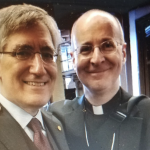Fr. James Martin’s impassioned plea in Building a Bridge for a new spirit of dialogue between the Church and the LGBT+ community continues to fuel divisive debate. Since its publication, critics and supporters have sparred over the book’s glaring omission of the Church’s magisterial teaching on homosexual relations.
Those supportive of the book’s overall appeal are generally satisfied by Fr. Martin’s response that the mention of such a divisive topic would only have been counterproductive and that the aim of the book was not to weigh in on matters of doctrine. But this answer has only furthered calls for Fr. Martin to clarify his position and to state his support of magisterial teaching. Dan Hitchens, writing at First Things, is one among many who have expressed concern that while Fr. Martin nowhere preaches directly against Church teaching, he also nowhere affirms it as true.
But in an article published here at Public Discourse, Robert George argues that Fr. Martin’s public confirmation of Church teaching, coupled with his repeated denials of seeking to alter a revealed truth of the faith, “removes doubt” and “no longer leaves room for detractors.” Citing Fr. Martin’s recent article in America Magazine, George writes that Fr. Martin has, “with no hint of ambiguity or evasion,” affirmed magisterial teaching as “valid, true, [and] binding to conscience.” To its credit, Fr. Martin’s article does acknowledge at some length the traditional scriptural and philosophical basis of the Church’s teaching on homosexuality, and at least tacitly approves of the Church’s statement that homosexual acts and the homosexual orientation are “objectively disordered.” Although the article says nothing about the merits of such teaching, or the benefit it may be to the human person, at the very least it does demonstrate a deference for magisterial authority and a willingness to respond to critics. It is also only fair to mention that the newly revised and expanded edition of Building a Bridge includes a complete citation of the catechism’s teaching on homosexuality (nos. 2357-2359), as well as an unqualified statement on the Church’s official position that sexual relations between people of the same sex are always impermissible.
So is the controversy now over?
Fr. Martin on Sexual Orientation
Start your day with Public Discourse
Sign up and get our daily essays sent straight to your inbox.George’s defense of Fr. Martin lands predominantly on Fr. Martin’s willingness to verbally assent to Church teaching and not on the substance of Fr. Martin’s argument, which remains unaddressed. Several substantive points—including Fr. Martin’s promotion of “Pride” events, his ongoing support of New Ways Ministry and Out at St. Paul’s, and his insistence that the Church adopt LGBT+ nomenclature—do make an appearance at the end of George’s article, but are treated only as minor points of ongoing disagreement. But these issues are not so inconsequential. Taken together, they represent a single critical issue that has yet to be resolved: Fr. Martin’s continued affirmation of sexual orientation as a valid basis of personal identity.
Building a Bridge, while timid in its defense of Christian teaching, is also brazenly emphatic that same-sex attraction serves as a genuine ground of personal, social, and cultural expression. The book advocates the Christian recognition of “gay” identity, calling on the Church to abandon its “antiquated” language of “homosexual persons” in favor of those terms chosen by the LGBT+ community. It is this premise that lies behind Fr. Martin’s willingness to support “Pride” events and to associate with organizations that unambiguously seek to change Church teaching. These challenges are further supported by the suggestion that failing to recognize and affirm the validity of “gay” and “lesbian” identity is in itself a failure of justice that devalues and “makes invisible” the dignity of LGBT+ persons.
The question George does not raise is whether Fr. Martin’s assent to Church teaching is not in fact undermined by the more substantive points of his position, given all that it affirms in terms of “gay” culture, language, and identity. George writes that Fr. Martin cannot consistently affirm Church teaching while simultaneously endorsing institutions that contradict it, yet he does not point out that Fr. Martin also cannot assent to magisterial teaching if his position demands the evacuation of its language and content. How can one assent to a doctrine while rejecting its material terms, such as the choice to say “homosexual” rather than “gay” or “inclination” rather than “orientation”?
Building a Bridge is strikingly silent on the theological implications of its position. In addition to giving no explanation for the theological foundations of Church teaching outside of appeals to naked authority, the book presents the Christian recognition of gay identity as a matter of little or no consequence. This not only deprives the Church of any justification for its moral teaching before the secular world, but is also patently untrue, as explained well by another voice in this ongoing discussion.
A Fundamentally Different Vision of the Human Person
Daniel C. Mattson, in his book Why I Don’t Call Myself Gay, explains clearly what an acceptance of gay identity implies, showing how a validation of LGBT+ terms carries within it a fundamentally new understanding of sexuality and the human person. Mattson courageously relates his own story of conversion to the rejection of his identity as a “gay” man. He speaks of his realization that words such as “heterosexual,” “homosexual,” “gay,” or “straight” are “just too limiting to be of any real value to reflect the dignity of man’s sexuality.” They sow confusion, particularly among young people, about the true source of human personhood. Such terms, Mattson writes, “lack objectivity.” They see the human person exclusively through the culturally fabricated “grid” of a so-called “orientation,” which is little more than a collectively decided-upon means of categorizing a set of personal experiences, inclinations, and behaviors.
To be clear, Mattson is not saying that subjective experiences are unimportant or immaterial to the formation of personal identity. They are, of course, vitally important, particularly with respect to the development of human sexuality. Mattson, rather, is pointing out that human emotional and sexual experiences can never be understood in isolation from a given order of creation that transcends them. The significance of a human experience, in other words, can only be rightly affirmed and interpreted against the backdrop of a more fundamental created goodness.
Mattson points to this order and its subsequent drama in human history when he highlights the “twofold expression of human nature, as male and female,” on the one hand, and the reality “that man as a fallen creature can experience a variety of attractions and desires,” on the other. While not inconsequential, the conclusion derived from this latter dimension is not in itself a sufficient basis for determining what is essential to human identity. In addition to the potential that such experiences could be false or misleading, they are also always framed by a more primary experience of created givenness—that is, the experience of being created as a man or a woman.
This is the heart of the matter. Mattson argues that, insofar as the language of being a “gay” man unavoidably circumscribes human identity between the categories of “straight” and some variation of “not straight,” it is not a benign descriptive term of the reality in question. The language of “gay” and “straight” orientations carries an entirely new judgment about the nature of sexuality as such, and with it a new understanding of the human person. In the first place, it construes human sexuality as originally without content, as something formless and androgynous, as though set before an infinite number of possible paths. In the second place, it conceives of the human person as abstracted from a sexual body, as someone who must first gather together an assortment of inclinations, attractions, and behaviors before receiving some manner of sexual “identity.” Put differently, the language of “gay” and “straight” orientations assumes that the primary order of created givenness is entirely insignificant, and thus approaches the distinction between “man” and “woman” as something over which a person exercises absolute authorial power.
To repeat: the language of “orientation” is not neutral with respect to the nature of human beings. It makes a fundamental claim about human nature and thus subjects all persons to what is essentially a “gay” anthropology.
Is Homosexual Identity a Social Construct?
In light of this claim, Mattson asks the pertinent question: “Do homosexual persons, as such, really exist as homosexuals, or is homosexuality, and the entire spectrum of sexual identities, a product of man’s imagination, and the result of social constructs?”
The term “social construct” may seem surprising here. Nowadays, we are trained to think that “male” and “female” are the constructs that artificially consolidate and restrain what is an otherwise “fluid” and unrestrained capacity to define oneself. Mattson’s point, however, is that the choice to frame human sexual identity in terms of an infinite number of possible behaviors is already a culturally influenced decision about the nature of the human person and of the natural world. This choice pivots on the words we use. With these words, we decide whether human sexuality is inconstant and indefinite before its consolidation into some form of “identity” or “orientation,” or whether it belongs more fundamentally to an objectively given substratum that human beings receive more than make. This is why the Church uses the language of a person having certain sexual tendencies (i.e., “same-sex attraction”) rather than a person being his or her sexual attractions, much less a chosen gender.
When Fr. Martin rejects the language of “same-sex attraction” as being superficial and dismissive of human sexual identity, he seems unaware that beyond this language lies a more fundamental affirmation. Is he aware that this language is based on the only theologically appropriate option for the Church, which can proclaim the full dignity and richness of the human person only if she can affirm the goodness of the given, created world in which human beings live?
Mattson’s book is a powerful witness to the grace of the Church’s teaching. It speaks to the emptiness and false promises of “coming out,” which he describes essentially as an experience of being habituated to a view of human personhood in which the person as he or she is as simply received is rendered insignificant. The “victory” of the gay rights movement in the twentieth century, in Mattson’s mind, is nothing but a further initiation into an already bleak and nihilistic outlook in which people are increasingly losing sight of the goodness of their existence.
Thus, the greatest fault of Fr. Martin’s book lies not so much with what it omits with respect to the Church’s moral teaching, but rather with its truncated view of the human person. His declaration that “people have a right to name themselves,” and that the Church—and the whole of reality, for that matter—are beholden to the “names” people choose for themselves, perpetuates a view of the human person as the sole source of meaning and order in the universe.
Upholding the Dignity and Truth of the Human Person
Fr. Martin’s seemingly benign plea for justice and equity for “gay” and “lesbian” individuals based on their equal capacity to achieve an integral and morally sound personhood is therefore deceptive in at least two respects. First, it is something of a sleight of hand. Whether persons with same-sex attraction are called to moral holiness or are capable of profound acts of moral heroism is not in question—of course they are. No one with any conscience would deny this. But, more importantly, by basing this plea on an affirmation of “gay” identity, Fr. Martin has conceded the more fundamental ground, essentially removing any dimension of man’s created givenness from the notion of justice. The key question is this: Can an identity that denies the given order of creation ever be just with respect to the full dignity of the human person? In the Church’s estimation, the answer is unequivocally no. Affirming this effectively eliminates the body from any order of created goodness and silences any significance to our being created man and woman.
Thus, the Church’s decision not to use the terms of the LGBT+ movement is a matter of profound prudence. Upon this rests her mission of mercy: to uphold the dignity and truth of the human person as a beloved creature tenderly made by God.
Fr. Martin insists that the terms “homosexual persons” and “objectively disordered” are “needlessly harmful” and “unnecessarily cruel.” But surely this impression of cruelty is most prevalent when such terms are used in contexts where the truth of the human person they are meant to defend and affirm is not expressed or articulated fully. The fact that such a distinguished author and pastor so immersed in this issue seems unaware of what the Church affirms in her teaching is perhaps itself indicative of a genuine crisis. Too often, the Church’s moral teaching is understood solely as a prohibition or as the censuring of certain behaviors, while what she simultaneously affirms of human goodness goes unacknowledged and unrecognized. This is the difference between seeing moral truths as prohibitory laws and treating them instead as protections that invite individuals in new depths of personal awareness and intimacy with God. As Christians, we must work to articulate our faith mercifully and in accordance with God’s gratuitous abundance.














